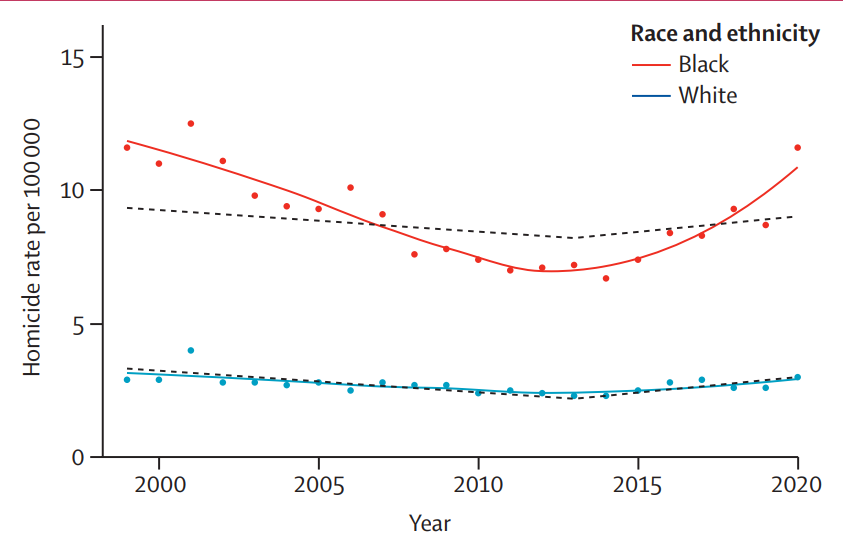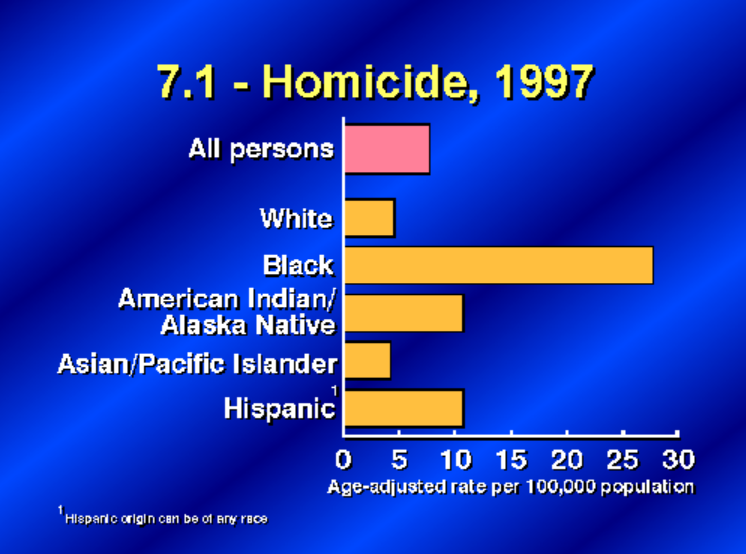A recent study has unveiled startling disparities in homicide rates affecting Black women in the United States, revealing they are six times more likely to fall victim to homicide compared to their white counterparts. The research, published in The Lancet medical journal, delves into the data collected by the Centers for Disease Control and Prevention’s National Vital Statistics System between 1999 and 2020, focusing on Black women aged 25 to 44 across 30 states.
Figure 1: Homicide rate per 100,000 among Black and White women aged 25–44 years in the USA from 1999 to 2020
 The The study categorizes deaths resulting from shootings, stabbings, and other violent means as homicides. Not remarkably the number of deaths for Blacks is also six times that of their white counterparts.
The The study categorizes deaths resulting from shootings, stabbings, and other violent means as homicides. Not remarkably the number of deaths for Blacks is also six times that of their white counterparts.

This comprehensive analysis aims to shed light on the underrepresented data concerning homicide rates among Black women and seeks to address the gaps in existing literature on the subject. The implications of these findings are profound, touching on the lives of family members, friends, and communities left devastated by such violence. Given the pivotal role of women in many Black families, the study underscores the far-reaching consequences of this violence on the community’s fabric.
Throughout history, Black women have navigated a complex maze of challenges, often bearing the brunt of systemic inequalities that permeate every aspect of life, from health and wealth to societal standing. Their resilience and strength have been tested time and again, facing adversities that are deeply rooted in the structural foundations of societies around the world. Yet, despite their enduring spirit and significant contributions across various fields, the stark realities of disparity and injustice remain ever-present. The recent findings that Black women are disproportionately more likely to fall victim to homicide than their white counterparts is a grim reminder of the persistent obstacles they face. This disturbing trend not only highlights the ongoing struggle for equality and justice but also raises poignant questions about the value placed on their lives within the societal hierarchy.
Isn’t it ironic, or perhaps more accurately, deeply disturbing, that Black women consistently find themselves at a disadvantage in virtually all aspects of life? The revelation that they are more likely to die compared to white women is neither surprising nor a deviation from the historical narrative; it’s a disheartening affirmation of the continuous uphill battle faced by the Black community. This situation begs the question: will there ever be a time when, statistically, Black women and the broader Black community can overcome these daunting odds? Will the disparities that have long cast a shadow over their progress ever truly be a thing of the past?
The disproportionate violence against Black women has long been a focal point for domestic violence advocates, including organizations like the National Domestic Violence Hotline. While the study stops short of pinpointing the exact causes behind these alarming statistics, it draws attention to underlying factors such as structural racism, encompassing aspects like poverty, education, and employment. The paper also notes that states with higher concentrations of low-income households, often characterized by closer living quarters, exhibit greater disparities in homicide rates.
Disturbingly, about 45% of Black women report experiencing stalking, physical violence, or sexual violence in their lifetimes, with intimate partner violence accounting for an estimated 51% of adult homicides among Black female victims, as per The National Coalition Against Domestic Violence. The study suggests that economic instability and widespread access to firearms exacerbate these issues, putting additional strain on relationships in impoverished communities.
Moreover, the study touches on the reluctance of many Black women to seek law enforcement assistance due to fear of neglect or abuse, further increasing their vulnerability to violence. A 2020 study highlighted that Black and Latina women facing intimate partner or sexual violence were significantly more likely to receive inadequate responses from law enforcement, compounded by factors like institutional racism and prevailing stereotypes.
In light of these findings, experts advocate for more open discussions about domestic violence within communities, schools, churches, and other institutions, emphasizing the need for a collective effort to address and mitigate these deeply ingrained issues.